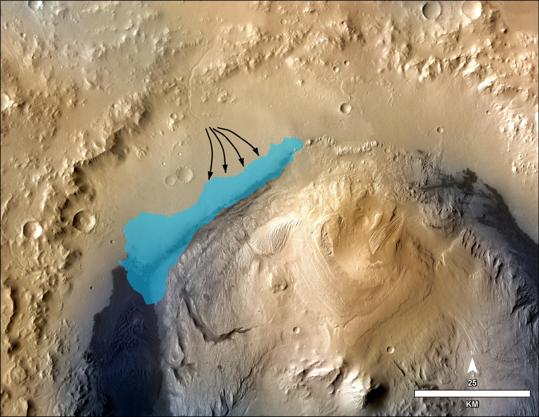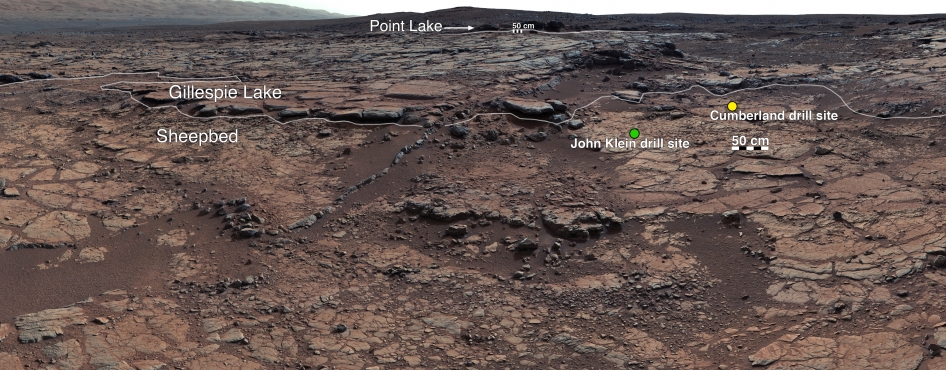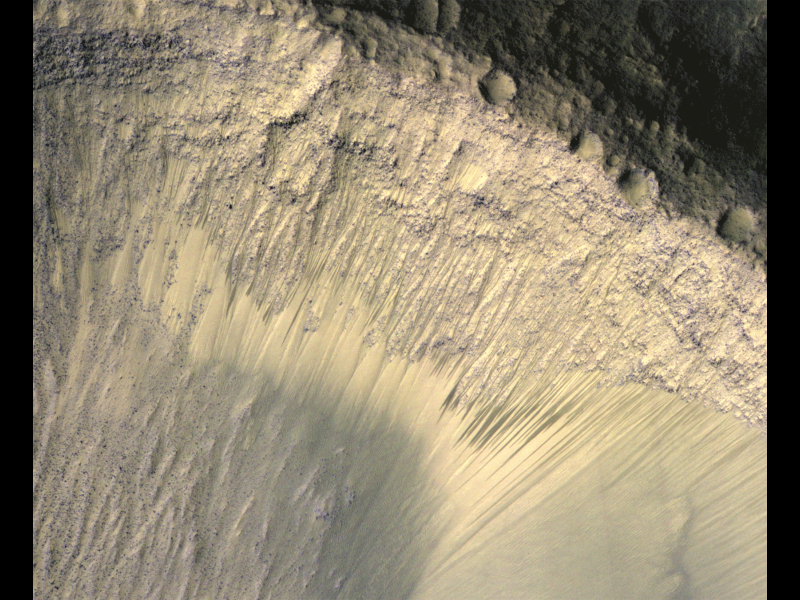
This week, NASA released some very interesting findings regarding water on Mars, from both the agency’s Curiosity rover and the Mars Reconnaissance Orbiter (MRO). It has been known for years that Mars did indeed have liquid water on its surface at some point; the aftermath is clearly visible all over the Red Planet’s desolate surface in the form of dried-up lake beds and river channels. On-site observations of rocks on the surface also prove the landscape was wet, with fast moving streams shaping the rocks and carving channels just like water does here on Earth. Round gravel—just like what is found at the bottom of streams here at home—is also found on Mars, and Curiosity has (again) shown that Mars could have supported life eons ago.
On Monday, Dec. 9, NASA announced that their Curiosity rover had uncovered strong evidence suggesting that an ancient 30-mile-long freshwater lake in Yellowknife Bay was indeed habitable for life as we know it. Matter of fact, it was so habitable that the liquid water in that lake (when it existed, of course) would have been drinkable. Large amounts of phyllosilicate clay minerals, which form in neutral pH water, were found in powdered rock samples analyzed by Curiosity’s SAM and CheMin instruments. Elements such as oxygen, carbon, sulfur nitrogen, hydrogen, and phosphorous have all been discovered as well at the ancient lake site, but Curiosity is still on the hunt for signatures of organic molecules.
“With this finding, we’re a significant step closer to understanding how to locate environments on Mars that can support life,” said John Grotzinger, project scientist for MSL from NASA’s Jet Propulsion Laboratory in Pasadena, California. “We know there are signs that water pooled or flowed in many other locations on Mars, and now we can be more confident that they may well have been habitable, too.”

Before Martian Armageddon occurred, the lake is believed to have existed for thousands, perhaps even tens of thousands of years before the planet’s atmosphere withered away and caused the lake to evaporate. Researchers cannot exactly date when the lake covered the landscape, but they can date how long ago Gale Crater formed: 3.5 billion years. The fact that a lake existed in the crater less than 3.5 billion years ago implies that a habitable water environment existed on the surface longer than was previously believed, which in turn would mean life had more time to evolve (if it was even present in the first place).
The question Curiosity set out to answer—”was Mars ever habitable at some point in its history”?—has been answered with a resounding yes; Curiosity has definitely found an environment that would have been habitable. Matter of fact, Curiosity determined 10 months ago that Mars was habitable, when the rover drilled into a rock and, after analyzing the minerals, discovered key chemical ingredients for life in the sample.
Now, as the team redirects Curiosity toward its ultimate destination at Mt. Sharp, the objective has changed. Curiosity is now on the hunt for the building blocks of life, searching for carbon-based organic molecules.
“Really what we’re doing is turning the corner from a mission that is dedicated to the search for habitable environments to a mission that is now dedicated to the search for that subset of habitable environments which also preserves organic carbon,” said Grotzinger. “That’s the step we need to take as we explore for evidence of life on Mars.”

Image Credit: NASA/JPL-Caltech/Univ. of Arizona
Meanwhile, orbiting some 150 – 250 miles above Curiosity and the Red Planet, NASA’s Mars Reconnaissance Orbiter (MRO) is making some very interesting observations of its own. Launched in 2005, MRO has—over the last couple years—observed seasonal patterns where finger-like dark markings appear to stream down slopes along the planet’s equator. Researchers now believe these slender “streams” might actually be salty liquid water flowing down steep slopes as the spring and summer seasons heat the Martian surface.
“The equatorial surface region of Mars has been regarded as dry, free of liquid or frozen water, but we may need to rethink that,” said Alfred McEwen of the University of Arizona in Tucson, principal investigator for MRO’s High Resolution Imaging Science Experiment (HiRISE) camera. “The explanation that fits best is salty water is flowing down the slopes when the temperature rises. We still don’t have any definite identification of water at these sites, but there’s nothing that rules it out, either.”
The features, which are typically less than 16 feet wide and no longer than 4,000 feet long, appear on both north-facing and south-facing walls of steep, rocky slopes in spring and summer, then fade as the temperatures drop with the coming of winter. Five well-monitored sites displaying these seasonal features are located in Valles Marineris, which is the largest canyon system in the entire Solar System.
Dissolved salts can keep water melted at temperatures when purer water freezes, and they can slow the evaporation rate so brine can flow farther. That process would definitely explain why liquid water might be flowing on the planet’s equatorial slopes during the planet’s warm seasons, but only future observations will prove whether or not MRO is truly seeing liquid water flow down the steep rocky slopes at Mars’ mid latitudes.
Want to keep up-to-date with all things space? Be sure to “Like” AmericaSpace on Facebook and follow us on Twitter: @AmericaSpace




I think you have got the decimal point in the wrong place for the height of MRO above the surface (15,000 miles). It is currently in a near circular 175 mile altitude orbit.
Stuart Hurst
Thank you for catching that Stuart, I have updated accordingly.
– Mike Killian
Then, is there fossils elsewhere, life on other planets? But, isn’t the emergence and maintenance of life a process of radical contingency? That is, is a unique and unrepeatable past totally necessary? Or does life emerge through space like mushrooms when some conditions are present? So, how many conditions are necessary: three, four, trillions, infinite? Only one, water or any sort of God? Is God the word that means infinite conditions, absolute necessity? Anyway, how did the life that emerge in a given conditions resist when switching to a different moment? How does life resist time itself, the effects of entropy? But, is it possible for human beings to recognise a simpler life than their own brain only? On the other hand, beyond likeness, is it possible to recognise a complex life than their brain, is this the extra-terrestrial life that some people are searching unsuccessfully? However, is there an origin of life or would it be as finding a cut in the material history of the universe, an infinite void that human language patches now? Is it the same cut between life and death? Along these lines, a serious-funny b-book, a preview in goo.gl/rfVqw6 Just another suggestion for mind leisure, far away from dogmas or axioms.
The fact that Curiosity had answered the question of whether Mars was inhabitable with “an astounding yes!” Is historic. That means that life elsewhere is not only possible but probable and will ultimately be answered with ever sophisticated robotic missions. I have always maintained that we will “make contact” (discovery of microbial life) and hopefully in our lifetime. Exciting times to be sure!
I think you meant “habitable” Tom!
The news from MRO’s observations over Mars’ mid-latitudes possibly seeing water leak through the surface during warmer seasons is exciting as well! I think, deep down in our gut, we know we are not alone, our fascination with the cosmos and with the timeless question of life elsewhere is no coincidence, at least in my opinion.
Thanks, Mike. Maybe “wishful thinking!”
As Tom and Mike have said, the recent findings from Curiosity are historic! Flowing water on Mars during the Martian summer? That was unthinkable 20 years ago. Indeed, the prospect of life on Mars, isn’t only possible, but probable. Why the recent news from Curiosity were neglected by the mainstream media, is beyond me.
As Mike stated, it’s a deep longing that drives us. I long for the day we make ‘contact’. That day will be really something!
Leonidas
Over the course of the last 40 years or so since the Viking Landers there has been one inconsistency after another as it relates to Mars climate and the assumed inhabitability of the planet by MSM and I think it has to do with the desire to keep the general public from knowing just how habitable Mars is because they do not want people going there or discussing going there. While there are many reasons they all pretty much can be summed up to one and that is money… Any human presence on Mars will require new technologies to be developed that will dramatically alter the energy infrastructure that exists on the Earth and the associated transportation, communications and governmental industries…The same could be said for Antarctica and why the world claimed it for non commercial research only…When temperatures average -125 F then new technology would need be created to adapt the human presence or rather not be created if the human presence is not allowed…